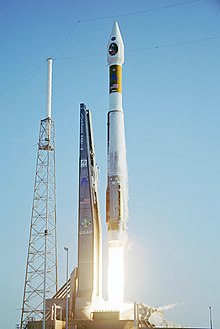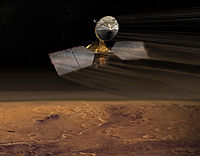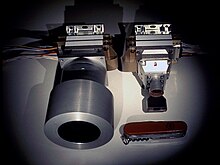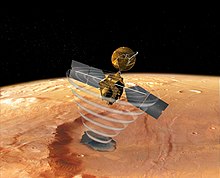Mars Reconnaissance Orbiter
NASA's Mars Reconnaissance Orbiter (MRO) is a multipurpose spacecraft designed to conduct reconnaissance and exploration of Mars from orbit. The $720 million USD spacecraft was built by Lockheed Martin under the supervision of the Jet Propulsion Laboratory, launched August 12, 2005, and attained Martian orbit on March 10, 2006.
The MRO contains a host of scientific instruments such as the HiRISE camera, CRISM, and SHARAD. The HiRISE camera will be used to analyze Martian landforms, whereas CRISM and SHARAD will detect water, ice, and minerals on and below the surface. Additionally, MRO will pave the way for upcoming generations of spacecraft through daily monitoring of Martian weather and surface conditions, searching for future landing sites, and testing a new telecommunications system that will enable the orbiter to send and receive information at an unprecedented bitrate. Data transfer to and from the spacecraft will occur faster than all previous interplanetary missions combined and allow it to serve as an important relay satellite for future missions.
The MRO has joined the Mars Express, Mars Odyssey, and Mars Global Surveyor in orbit around Mars. In addition to the two Mars Exploration Rovers on the surface, the orbiter will be the sixth active Martian spacecraft - the largest number around any extraterrestrial planet in the human history of space exploration.
Overview, launch, and orbital insertion

The Mars Reconnaissance Orbiter (MRO) launched on August 12, 2005 from Space Launch Complex 41 at Cape Canaveral Air Force Station, aboard an Atlas V-401 rocket equipped with a Centaur upper stage. Fifty-six minutes after launch the Centaur completed its burns placing MRO in interplanetary transfer orbit towards Mars.[1] The launch was postponed from the previous day after discovering in the few minutes before liftoff that the computer software monitoring the fuel systems was malfunctioning.[2]
Designed by the National Aeronautics and Space Administration (NASA) and constructed at a cost of $720 million,[3] the Mars Reconnaissance Orbiter is intended to lay the groundwork for NASA's planned surface missions: the Phoenix Lander lander to explore the Martian Arctic, and the Mars Science Laboratory, a highly manueverable rover being developed for a 2009 launch opportunity. The MRO's high-resolution instruments will help planners evaluate possible landing sites for these missions in terms of potential for scientific discoveries and landing risks. MRO will also provide a transmission relay as well as critical navigation data to the surface missions during their landing. MRO may also help uncover the reasons behind the failure of past Mars missions such as NASA's Mars Polar Lander and the British Beagle lander.[4]
MRO cruised through interplanetary space for 7.5 months before reaching Mars. During the cruise, testing and calibration of most of the scientific instruments and experiments were conducted. Four trajectory correction maneuvers were planned for proper orbital insertion upon reaching Mars, however, only three were undertaken as the fourth was deemed unnecessary. A fifth emergency trajectory correction was also discussed but withdrawn.[5] The spacecraft entered orbit precisely as planned and on schedule. "Oh, look, it's right on the money!" shouted one NASA engineer. "Right on the money!"[6]
The start of the orbital insertion occurred as MRO approached Mars for the first time on March 10 2006, passing above the Martian southern hemisphere at an altitude of about 370–400 km (190 statute miles). All six of the orbiter’s main engines burned for 27 minutes reducing the speed of the probe (relative to Mars at closest approach) from ~2,900 m/s to ~1,900 m/s (6,500 mph to 4,250 mph). The helium pressurization tank was colder than expected reducing the pressure in the fuel tank by about 21 kiloPascal (3 psi). This caused the engine thrust to be diminished by 2%, but MRO automatically compensated by extending the burn time by 33 seconds. [7]

Orbital insertion placed the orbiter in a highly elliptical polar orbit. Shortly after insertion, the periapsis — the closest point in the orbit to Mars — was 3,806 km from the center of Mars (~426 km from the surface). The apoapsis, or farthest point in the orbit from Mars, was 47,972 km from the center of Mars or approximately 43,000 km from the surface. The orbital period was approximately 35.5 hours.[8]
Aerobraking is currently being conducted to bring the orbiter to a lower, shorter-period orbit. The process of aerobraking reduces the fuel needed to reach the desired orbit roughly in half and consists of three steps: First, during the first five planetary orbits (one Earth week), MRO dropped the periapsis of its orbit into aerobraking altitude using its thrusters. Aerobraking altitude depends on the thickness of the Martian atmosphere because Martian atmospheric density changes with its seasons. Second, MRO is maintaining aerobraking altitude for about 550 planetary orbits (5.5 Earth months) using the vehicle's thrusters to make occasional corrections in its periapsis altitude. Through aerobraking, the apoapsis of the orbit will be reduced to 450 km (280 miles). Finally, to end aerobraking, MRO will use its thrusters to move its periapsis out of the edge of the Martian atmosphere.[9]
After aerobraking concludes, one or two weeks will be spent to make additional adjustments in MRO's orbit using its thrusters. From October 7 to November 8, 2006 a solar conjunction will occur as the Sun passes between Mars and the Earth, but science operations will begin after the conjunction ends. SHARAD will be deployed when MRO reaches its final orbit[9] for science operations, approximately 255 to 320 km (160 to 200 miles) above the Martian surface.
Science operations and extended mission

Beginning in November 2006, science operations will be conducted for a period of two Earth years. One of the mission's main goals is to map the Martian landscape with high-resolution cameras. This is primarily to choose the best landing sites for future landers and rovers. The Martian climate, weather, and atmosphere will also be studied with on-board scientific equipment, and MRO will search for signs of water either in the polar caps or underground. New technology will be advance tested as part of the package. The MRO will also look for the remains of the previously lost Mars Polar Lander and Beagle 2, and the spacecraft will serve as the first step in setting up an internet protocol for the different planets within our solar system. After its main science operations are completed, the probe's extended mission will continue using the communication and navigation system for future lander and rover probes.[10]
Six science instruments are included on the mission along with two "science-facility instruments", which use data from engineering subsystems to collect science data. Three technology experiments will test and demonstrate new equipment for future missions.[11]
HiRISE

The High Resolution Imaging Science Experiment camera consists of a 0.5 meter reflecting telescope, the largest of any deep space mission, and has a resolution of 1 microradian, or 0.3 m at a height of 300 km. (For comparison purposes, satellite images of Earth are generally available to a resolution of 0.1 meter, and satellite images on Google Maps are available to 1 meter.[12]) It can image in three color bands, 400-600 nm (blue-green or B-G), 550-850 nm (red) and 800-1,000 nm (near infrared or NIR).[13]
Red color images are at 20,264 pixels wide (6 km in a 300 km orbit), and Green-Blue and NIR are at 4,048 pixels wide (1.2 km). HiRISE's onboard computer reads out these lines in time with the orbiter's ground speed, meaning the images are potentially unlimited in height. Practically this is limited by the onboard computer's 28 Gigabit(Gb) memory capacity. The nominal maximum resolution of red images is 20,000 × 40,000 pixels, or 800 megapixels and 4,000 × 40,000 pixels (160 megapixels) for the narrower images of the B-G and NIR bands. A single uncompressed image will use 16.4 Gb. However, these images will be transmitted compressed, at a total size of 5 Gigabits. These images will be released to the general public on the HiRISE website via a new format called JPEG 2000.[14],[15], To facilitate the mapping of potential landing sites, HiRISE can produce stereo pairs of images from which the topography can be measured to an accuracy of 0.25 m.[16]
Other Cameras
The Context Imager (CTX) will provide grayscale images (500 nm to 800 nm) of surface areas up to 40 km wide with a pixel resolution of 8 meters. The CTX is designed to operate in conjunction with HiRISE and CRISM to provide, as the name describes, context maps for the areas being observed. The optics consist of a 350 mm focal length Maksutov Cassegrain telescope with a 5064 pixel wide line array CCD, similar to the HiRISE instrument. The instrument will take pictures that are about 30 kilometer (19 mi) long, and has enough memory on board to record a 160 km long "track" before the image is loaded into the main computer with its 20Gb storage capacity.[17]

The Mars Color Imager (MARCI) will image the entire surface of Mars every day in five visible and two ultraviolet bands. It is designed to be a wide-angle low-resolution camera. It will take 7 low-resolution pictures per orbit, and at almost 13 orbits per Martian day, MARCI will be able to produce a daily global map to help characterize daily, seasonal and year-to-year variations in Mars' climate, as well as providing daily weather reports for Mars. [18]
Spectrometry, infrared and radar equipment

The Compact Reconnaissance Imaging Spectrometer for Mars (CRISM) instrument is an infrared/visible light spectrometer, to produce detailed maps of the mineralogy of the surface of Mars. It has a resolution of 18 meters at a 300 km orbit. It will operate from 370 nm to 3920 nm, measuring the spectrum in 560 channels, each 6.55 nm wide.[19]
The Mars Climate Sounder (MCS) is a nine-channel spectrometer with one visible/near infrared channel (0.3 to 3.0 micrometers) and eight far infrared (12 to 50 micrometers). These channels are selected to measure temperature, pressure, water vapor and dust levels. It will observe the atmosphere on the horizon of Mars (as viewed from MRO), breaking it up into vertical slices, and taking measurements within these slices at heights separated by about 5 km (3 miles). These measurements will be assembled into daily global weather maps, showing the basic variables of Martian weather: temperature, pressure, humidity and dust density.[20]

The orbiter's Shallow Subsurface Radar (SHARAD) experiment is designed to probe the internal structure of Mars' polar ice caps, as well as to gather information planet-wide about underground layers of ice, rock and, perhaps, liquid water that might be accessible from the surface. SHARAD operates between 15 and 25 MHz HF radio waves and will be able to resolve layers as thin as 7 meters to a maxiumum depth of 1 km. It will have a horizontal resolution as high as 0.3 by 3 km. SHARAD is designed to operate in conjunction with Mars Express MARSIS radar which has lower resolution but much greater penetrating depth. Both instruments were made by the Italian Space Agency.[21][22]
Engineering Instruments
There are a variety of additional instruments on the MRO contributing to Martian knowledge. The Gravity Field Investigation Package will measures variations in the Martian gravitational field through variations in the spacecraft's velocity detected by doppler shift variances in radio signals received on Earth. Sensitive accelerometers aboard the orbiter will be used to deduce the in situ atmospheric density. This experiment is conducted during aerobraking, when MRO is in denser parts of the atmosphere.[23]
The Electra, a UHF antenna, is designed to communicate with spacecraft as they approach, land, and operate on Mars, and will also aid in landing navigation and positioning. When vehicles land safely on the surface Electra will provide Doppler that, combined with MRO's positional information, accurately determines location. Additionally, the system will provide radio contact with surface vehicles and route data to NASA if the vehicle's own antenna does not have sufficient radio power to contact controllers.[24]
The Optical Navigation Camera will image the Martian moons Phobos and Deimos against background stars, to precisely determine MRO's orbit. Although moon imaging is not mission critical, it has been included as a technology test for future orbiting and landing of spacecraft.[25] The Optical Navigation Camera was tested successfully in February and March of 2006.[26]
Engineering data

Structure
Workers at Lockheed Martin Space Systems in Denver, assembled the spacecraft structure and attached instruments. In addition to the Jet Propulsion Laboratory, instruments were built for it at the University of Arizona's Lunar and Planetary Laboratory, in Tucson, Arizona, Johns Hopkins University's Applied Physics Laboratory in Laurel, Maryland, the Italian Space Agency in Rome, Italy and at the Malin Space Science Systems operations in San Diego, California.[27]
The structure is made of mostly carbon composites, as well as aluminium honeycombed plates. The titanium fuel tank takes up most of the volume and mass of the spacecraft and provides most of its structural integrity. The spacecraft's total mass is less than 2,180 kg (4,806 lb) with an unfueled dry mass less than 1,031 kg (2,273 lb).[28]
Power systems

The Mars Reconnaissance Orbiter gets all of its electrical power from two solar panels, each of which can move independently around two axes of movement (up-down, or left-right rotation). Each solar panel measures 5.35 × 2.53 meters and has 9.5 meters² (102 feet²) covered with 3,744 individual photovoltaic cells. The very high efficiency triple junction solar cells are able to convert more than 26% of the Sun's energy directly into electricity and are connected together to produce a total output of 32 volts. At Mars, the two panels produce 2,000 watts of power, in contrast to the 6,000 watts that would be generated in a comparable Earth orbit due to being closer to the Sun.[29]
MRO has two nickel metal hydride rechargeable batteries used to power the spacecraft when it is not facing the sun. Each battery has an energy storage capacity of 50 ampere-hours (180 kC). The full range of the batteries cannot be used due to voltage constraints on the spacecraft, however, this will allow the operators to extend the battery life, one of the main causes of long-term satellite failure. Planners anticipate that only 40% of the batteries capacities will be required for the lifetime of the spacecraft. [29]
Electronic systems
MRO‘s main computer is a 133 MHz, 10.4 million transistor, 32-bit, RAD750 processor. This processor is a radiation hardened version of a PowerPC 750 or G3 processor with a specially built motherboard. The RAD750 is a successor to the RAD6000. This processor may seem underpowered in comparison to a modern PC or Mac processor, but it is extremely reliable, resilient, and can function in solar flare-ravaged deep space.[30] The operating system software is VxWorks and has extensive fault protection protocols and monitoring. [31]
Data is stored in a 160 Gbit (20 GB) flash memory module consisting of over 700 memory chips, each with 256 Mbit capacities. This memory capacity is not actually that large considering how much data is going to be acquired; for example, a single image from HiRISE camera can be as big as 28 Gbit.[31]
Attitude Determination
In order to adjust orbit and maneuvers, sixteen Sun sensors — eight active and eight backups — are placed around the spacecraft to calibrate solar direction relative to the orbiter's frame. Two star trackers, digital cameras used to map the position of catalogued stars, provide NASA with full, three-axis knowledge of the spacecraft orientation and attitude. A primary and back-up inertial measurement monitor will measure changes to the spacecraft attitude as well as any non-gravitionally induced changes to its linear velocity. Each inertial measurement unit is a combination of three accelerometers and three ring-laser gyroscopes.[32]
Telecommunications system

The Telecom Subsystem uses a large antenna to transmit data through the Deep Space Network via X-band frequences at 8 GHz, and it will demonstrate the use of the Ka-band at 32 GHz for higher data rates. Maximum transmission speed from Mars is projected to be as high as 6 Mbit/s, a rate ten times higher than previous Mars orbiters. [33] The spacecraft carries two 100-watt X-band amplifiers (one of which is a backup), one 35-watt Ka-band amplifier, and two transponders.[33]
Two smaller low-gain antennas are also present for lower-rate communication during emergencies and special events, such as launch and Mars Orbit Insertion. These antennas do not have focusing dishes and can transmit and receive from any direction.[33]
Propulsion and Attitude Control

The spacecraft uses a 1175-liter (310 US gallon) fuel tank filled with 1187 kg (2617 lbs) of hydrazine monopropellant. Fuel pressure is regulated by adding pressurized helium gas from an external tank. Seventy percent of the fuel will be used for orbital insertion.[34]
There are total of 20 rocket engine thrusters onboard. Six large thrusters, mainly meant for orbital insertion, each producing 170 Newtons (38 lbf) of thrust for a total of 1,020 N (230 lbf). These thrusters were originally designed for the Mars Surveyor 2001 Lander. There are six medium thrusters to perform trajectory correction maneuvers and attitude control during orbit insertion, each producing 22 Newtons (5 lbf) of thrust, and eight small thrusters for attitude control during normal operations, each producing 0.9 N (0.2 lbf) of thrust.[34]
Four reaction wheels are also used for precise attitude control such as during high-resolution imaging, where even small motions can cause blurring of the image. Each wheel is used for one axis of motion. The fourth (skewed) wheel is a backup in case one of the other three wheels fails. Each wheel weighs 10 kg (22 lb) and can be spun as fast as 100 Hz or 6,000 rpm.[34]
Footnotes
- ^ "NASA's Multipurpose Mars Mission Successfully Launched". NASA Press Release from August 12, 2005. Retrieved May 30.
{{cite web}}: Check date values in:|accessdate=(help); Unknown parameter|accessyear=ignored (|access-date=suggested) (help) - ^ "NASA Delays Mars Orbiter Launch (August 11, 2005)". CBS-5 - San Francisco. Retrieved May 27.
{{cite web}}: Check date values in:|accessdate=(help); Unknown parameter|accessyear=ignored (|access-date=suggested) (help) - ^ NASA Authorization Act of 2004, S.2541. thomas.loc.gov. URL accessed on May 27, 2006)
- ^ "Mars Reconnaissance Orbiter Overview". Mars Reconnaissance Orbiter Website. Retrieved February 11.
{{cite web}}: Check date values in:|accessdate=(help); Unknown parameter|accessyear=ignored (|access-date=suggested) (help) - ^ "Mars Reconnaissance Orbiter: Multimedia". Retrieved May 28.
{{cite web}}: Check date values in:|accessdate=(help); Unknown parameter|accessyear=ignored (|access-date=suggested) (help) - ^ "U.S. Spacecraft Enters Orbit Around Mars". New York Times March 11, 2006. Retrieved May 30.
{{cite web}}: Check date values in:|accessdate=(help); Unknown parameter|accessyear=ignored (|access-date=suggested) (help) - ^ ""Spaceflight Now" MRO Mission Status Center". Retrieved March 12.
{{cite web}}: Check date values in:|accessdate=(help); Unknown parameter|accessyear=ignored (|access-date=suggested) (help) - ^ ""New Mars Orbiter Ready for Action"". Space.com. Retrieved May 28.
{{cite web}}: Check date values in:|accessdate=(help); Unknown parameter|accessyear=ignored (|access-date=suggested) (help) - ^ a b "" Mission Timeline: Aerobraking"". Mars Reconnaissance Orbiter: The Mission. Retrieved May 28.
{{cite web}}: Check date values in:|accessdate=(help); Unknown parameter|accessyear=ignored (|access-date=suggested) (help); horizontal tab character in|title=at position 3 (help) - ^ "Mission Timeline: Communications Relay". Mars Reconnaissance Orbiter Website. Retrieved May 28.
{{cite web}}: Check date values in:|accessdate=(help); Unknown parameter|accessyear=ignored (|access-date=suggested) (help) - ^ "Spacecraft Parts: Instruments". Mars Reconnaissance Orbiter Website. Retrieved February.
{{cite web}}: Check date values in:|accessdate=(help); Unknown parameter|accessyear=ignored (|access-date=suggested) (help) - ^ "Google Earth FAQ" Google Earth Website.
- ^ "MRO HiRISE Camera Specifications". HiRISE website. Retrieved 2 January.
{{cite web}}: Check date values in:|accessdate=(help); Unknown parameter|accessyear=ignored (|access-date=suggested) (help) - ^ "HiRISE: Instrument Development" (PDF). NASA Ames Research Center website. Retrieved 7 February.
{{cite web}}: Check date values in:|accessdate=(help); Unknown parameter|accessyear=ignored (|access-date=suggested) (help) (PDF) - ^ "Fact Sheet: HiRISE" (PDF). National Air and Space Museum. Retrieved 18 February.
{{cite web}}: Check date values in:|accessdate=(help); Unknown parameter|accessyear=ignored (|access-date=suggested) (help) (PDF) - ^ "HiRISE". HiRISE website. Retrieved May 28.
{{cite web}}: Check date values in:|accessdate=(help); Unknown parameter|accessyear=ignored (|access-date=suggested) (help) - ^ "MRO Context Imager (CTX) Instrument Description". Malin Space Science Systems website. Retrieved 17 August.
{{cite web}}: Check date values in:|accessdate=(help); Unknown parameter|accessyear=ignored (|access-date=suggested) (help) - ^ ""Spacecraft Parts: Instruments: MARCI"". MARCI website. Retrieved June 2.
{{cite web}}: Check date values in:|accessdate=(help); Unknown parameter|accessyear=ignored (|access-date=suggested) (help) - ^ "CRISM Instrument Overview". CRISM Instrument Website. Retrieved April 2.
{{cite web}}: Check date values in:|accessdate=(help); Unknown parameter|accessyear=ignored (|access-date=suggested) (help) - ^ "Spacecraft Parts: Instruments: MCS". CRISM Instrument Website. Retrieved May 28.
{{cite web}}: Check date values in:|accessdate=(help); Unknown parameter|accessyear=ignored (|access-date=suggested) (help) - ^ "Spacecraft Parts: SHARAD" (PDF). Peer Review Papar website (PDF Format). Retrieved August.
{{cite web}}: Check date values in:|accessdate=(help); Unknown parameter|accessyear=ignored (|access-date=suggested) (help) - ^ KOMO-TV News Staff (August 12, 2005). NASA Launches Mars Orbiter. KOMO-TV.
- ^ "Spacecraft Parts: Gravity Field Investigation Package". Mars Reconnaissance Orbiter Website. Retrieved May 28.
{{cite web}}: Check date values in:|accessdate=(help); Unknown parameter|accessyear=ignored (|access-date=suggested) (help) - ^ "Spacecraft Parts: Electra". Mars Reconnaissance Orbiter Website. Retrieved February.
{{cite web}}: Check date values in:|accessdate=(help); Unknown parameter|accessyear=ignored (|access-date=suggested) (help) - ^ "Spacecraft Parts: Optical Navigation Camera". Mars Reconnaissance Orbiter Website. Retrieved February.
{{cite web}}: Check date values in:|accessdate=(help); Unknown parameter|accessyear=ignored (|access-date=suggested) (help) - ^ "Optical Navigation Demonstration Near Mars Multimedia Feature". NASA Mars Reconnaissance Orbiter Website. Retrieved March.
{{cite web}}: Check date values in:|accessdate=(help); Unknown parameter|accessyear=ignored (|access-date=suggested) (help) - ^ ""Rad 750"". BAE Aerospace Parts. Retrieved May 28.
{{cite web}}: Check date values in:|accessdate=(help); Unknown parameter|accessyear=ignored (|access-date=suggested) (help) - ^ ""Spacecraft Summary"". NASA's MRO website. Retrieved May 29.
{{cite web}}: Check date values in:|accessdate=(help); Unknown parameter|accessyear=ignored (|access-date=suggested) (help) - ^ a b ""Spacecraft Parts: Electrical Power"". NASA's MRO website. Retrieved May 28.
{{cite web}}: Check date values in:|accessdate=(help); Unknown parameter|accessyear=ignored (|access-date=suggested) (help) - ^ ""Rad 750"" (PDF). BAE aerospace parts. Retrieved May 28.
{{cite web}}: Check date values in:|accessdate=(help); Unknown parameter|accessyear=ignored (|access-date=suggested) (help) - ^ a b "Spacecraft Parts: Command and Data-Handling Systems". NASA's MRO website. Retrieved May 28.
{{cite web}}: Check date values in:|accessdate=(help); Unknown parameter|accessyear=ignored (|access-date=suggested) (help) - ^ "Spacecraft Parts: Guidance, Navigation, and Control Systems". NASA's MRO website. Retrieved May 28.
{{cite web}}: Check date values in:|accessdate=(help); Unknown parameter|accessyear=ignored (|access-date=suggested) (help) - ^ a b c ""Spacecraft Parts: Telecommunications"". NASA's MRO website. Retrieved May 28.
{{cite web}}: Check date values in:|accessdate=(help); Unknown parameter|accessyear=ignored (|access-date=suggested) (help) - ^ a b c "Spacecraft Parts: Propulsion". NASA's MRO website. Retrieved May 28.
{{cite web}}: Check date values in:|accessdate=(help); Unknown parameter|accessyear=ignored (|access-date=suggested) (help)
Further reading
- Mishkin, Andrew (2004). Sojourner : An Insider's View of the Mars Pathfinder Mission. ISBN 0425191990.
- Squyres, Steve (2005). Roving Mars : Spirit, Opportunity, and the Exploration of the Red Planet. ISBN 1401301495.
- Read, Peter L. & Lewis, Steven L. (2004). The Martian Climate Revisited : Atmosphere and Environment of a Desert Planet. ISBN 354040743X.
{{cite book}}: CS1 maint: multiple names: authors list (link) - Zubrin, Robert (1997). The Case for Mars. ISBN 0684835509.
See also
External links
- Mars Reconnaissance Orbiter website at NASA
- Mars Reconnaissance Orbiter website at JPL
- Mars Reconnaissance Orbiter images at JPL
- HiRISE Instrument website
- ILS information for launch vehicle AV-007
- Slashdot: Ham Hears Mars Orbiter 45 Million Miles From Earth
- Mars Reconnaissance Orbiter Reception
- Video stream of mission (requires Java)
- CRISM website
- CTX website
- MARCI website
- SHARAD website



